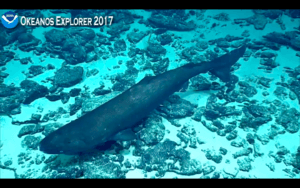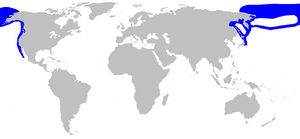Pacific sleeper shark facts for kids
Quick facts for kids Pacific sleeper shark |
|
|---|---|
 |
|
| Conservation status | |
| Scientific classification | |
| Genus: |
Somniosus
|
| Species: |
pacificus
|
 |
|
| Range of the Pacific sleeper shark | |
The Pacific sleeper shark (Somniosus pacificus) is a very large shark. It belongs to the sleeper shark family. You can find these sharks in the northern Pacific Ocean. They live in both Arctic and warmer, temperate waters.
These sharks usually stay near the ocean floor and slopes. They can be found from the surface all the way down to about 2,000 meters (6,500 feet) deep. The Pacific sleeper shark can grow up to 4.4 meters (14 feet) long. Some scientists think they might even reach over 7 meters (23 feet)!
Contents
What Pacific Sleeper Sharks Eat
Pacific sleeper sharks are amazing hunters. They are thought to be both predators and scavengers. This means they hunt live animals and also eat dead ones. They can glide through the water very quietly. This makes them excellent stealth hunters.
These sharks have huge mouths. They can suck in their prey like a vacuum cleaner! If a food item is too big, their sharp teeth can cut it into smaller pieces. When they eat, they often roll their heads.
Most of what we know about their diet comes from studies in Alaska. Their favorite food seems to be the North Pacific giant octopus. They also eat fish that live on the bottom, like soles and flounders. Other foods include Alaska pollock, rockfishes, shrimps, hermit crabs, and even marine snails.
Bigger Pacific sleeper sharks eat faster-moving prey. This includes squids, Pacific salmon, and even harbor porpoises. As they grow, their diet becomes more varied. For example, a large female shark found off California had eaten mostly giant squid.
Pacific Sleeper Shark Reproduction
Scientists don't know much about the early life of Pacific sleeper sharks. They believe these sharks are ovoviviparous. This means the eggs hatch inside the mother's body. The pups then develop inside her until they are ready to be born.
The exact time it takes for the pups to develop is unknown. However, it's thought that a mother shark might have around 10 pups at a time. When they are born, the baby sharks are quite small. They are usually about 42 centimeters (1.4 feet) long or even less.
How Big Do Pacific Sleeper Sharks Get?
An average adult Pacific sleeper shark is about 3.65 meters (12 feet) long. They usually weigh between 318 and 363 kilograms (700-800 pounds). The largest confirmed Pacific sleeper shark was 4.4 meters (14 feet) long. It weighed a massive 888 kilograms (1,958 pounds).
Some experts believe they can grow even larger, possibly over 7 meters (23 feet). In 1989, a huge Pacific sleeper shark was filmed near Tokyo Bay, Japan. A famous shark scientist, Eugenie Clark, estimated it was about 7 meters long.
Amazing Adaptations of the Pacific Sleeper Shark
Pacific sleeper sharks live in very cold, deep waters. They have special ways to survive there. Their liver oil is different from many other sharks. It doesn't contain squalene, which would freeze in the cold. Instead, their liver has special compounds that stay liquid even in freezing temperatures. This helps them stay afloat.
Like other deep-sea sharks, they don't store much urea in their skin. But they have high amounts of urea and trimethylamine oxide in their tissues. These chemicals help them deal with the high pressure and cold. They also help them stay buoyant.
Food is hard to find on the deep ocean floor. So, the sleeper shark has a very large stomach. This allows it to store a lot of food when it finds it. Their jaws are short and strong, giving them a powerful bite.
Their teeth are also unique. The upper jaw has spike-like teeth for grasping prey. The lower jaw has overlapping, slanted teeth. This setup helps them hold and saw through food that is too big to swallow whole. They also have a short tail fin. This helps them save energy for quick bursts of speed to catch prey.
In 2015, a Pacific sleeper shark was filmed near the Solomon Islands. It was swimming near an active underwater volcano! This shows these sharks can survive in very hot and acidic water.
Who Hunts the Pacific Sleeper Shark?
Pacific sleeper sharks do have predators. One known predator is a type of killer whale found off British Columbia. These killer whales hunt sleeper sharks.
Also, a tiny parasite called Ommatokoita elongata can be found on these sharks. This parasite is a type of copepod. It often attaches to the shark's eye and eats its eye tissue. This is similar to what happens to the Greenland shark.
See also
 In Spanish: Tiburón dormilón del Pacífico para niños
In Spanish: Tiburón dormilón del Pacífico para niños



